Courtesy: Wikipedia
Main articles: Health care in Mexico and Education in Mexico. See also 2009 swine flu outbreak.
Since the early 1990s, Mexico entered a transitional stage in the health of its population and some indicators such as mortality patterns are identical to those found in highly developed countries like Germany or Japan.[213] Although all Mexicans are entitled to receive medical care by the state, 50.3 million Mexicans had no medical insurance as of 2002.[214] Efforts to increase the number of people are being made, and the current administration intends to achieve universal health care by 2011.[215][216]
Mexico's medical infrastructure is highly rated for the most part and is usually excellent in major cities,[217][218] but rural areas and indigenous communities still lack equipment for advanced medical procedures, forcing patients in those locations to travel to the closest urban areas to get specialized medical care.[219]
State-funded institutions such as Mexican Social Security Institute (IMSS) and the Institute for Social Security and Services for State Workers (ISSSTE) play a major role in health and social security. Private health services are also very important and account for 13% of all medical units in the country.[220]
| Educational oversight Minister of Public Education | Secretariat of Public Education Josefina Vázquez Mota |
| National education budget (2007) | MXN $1,309,691,048,383 USD $148,342,469,250 |
| Primary language(s) of education | Spanish as the standard. Other minority languages are also available in their local communities. |
| Nationalized system Establishment | 25 September 1921 |
| Literacy (2006) • Men • Women | 97.7 % 98.4% 96.8 % |
| Enrollment • Primary • Secondary • Post-secondary | 61.6 million 26.4 million 19.8 million 15.3 million |
| Attainment • Secondary diploma • Post-secondary diploma | N/A N/A |
| Sources: Sistema Educativo de los Estados Unidos Mexicanos. Principales cifras, ciclo escolar 2003-2004 pdf and the 2000 Census (INEGI) | |
Education in Mexico is highly competitive and actively pursued especially in Amerindian communities as it as seen as the primary path to success and employment. Mexico has one of the highest student-to-teaching staff ratio in the world with 26 students per teacher nationwide, when all levels from pre-K through post secondary education are included.[221] According to the OCED, compared to students from the worlds thirty most developed nations, Mexican students came in fourth in problem solving, third in science and technology and eighth in mathematics.[222] Mexico has one of the largest educational budgets in the world meausured by actual spending and as a percentage of GDP. In 2009 the educational budget was $148 billion equalling 9.7% of total GDP. In 2004, the literacy rate was at 97%[223] for youth under the age of 14 and 91% for people over 15,[224] placing Mexico at the 24th place in the world rank accordingly to UNESCO.[225] Primary and secondary education (9 years) is free and mandatory. Even though different bilingual education programs have existed since the 1960s for the indigenous communities, after a constitutional reform in the late 1990s, these programs have had a new thrust, and free text books, software, and vocational programs are available in more than a dozen indigenous languages.
In the 1970s, Mexico established a system of "distance-learning" through satellite communications to reach otherwise inaccessible small rural and indigenous communities. Schools that use this system are known as telesecundarias in Mexico. The Mexican distance learning secondary education is also transmitted to some Central American countries and to Colombia, and it is used in some southern regions of the United States as a method of bilingual education. There are approximately 30,000 telesecundarias and approximately a million telesecundaria students in the country.[226]
The largest and most prestigious public university in Mexico, today numbering over 269,000 students, is the National Autonomous University of Mexico (Universidad Nacional Autónoma de México, UNAM) founded in 1910. Three Nobel laureates and most of Mexico's modern-day presidents are among its former students. UNAM conducts an astounding 50% of Mexico's scientific research and has presence all across the country with satellite campuses and research centers. The National Autonomous University of Mexico ranks 15th place in the Top 200 World University Ranking published by The Times Higher Education Supplement in 2008,[227] making it the highest ranked Spanish-speaking university in the world and the highest ranked in Latin America. The second largest university is the National Polytechnic Institute (IPN). These institutions are public, and there are at least a couple of public universities per state.
One of the most prestigious private universities is Monterrey Institute of Technology and Higher Education (ITESM). It was ranked by the Wall Street Journal as the 7th top International Business School worldwide[228] and 74th among the world's top arts and humanities universities ranking of The Times Higher Education Supplement, published in 2005. ITESM has thirty-two secondary campuses, apart from its Monterrey Campus. Other important private universities include Mexico's Autonomous Technological Institute (ITAM), ranked as the best economics school in Latin America, Fundación Universidad de las Américas, Puebla (UDLAP) and the Ibero-American University (Universidad Iberoamericana).
In April 2009 Mexico saw the outbreak of a new strain of H1N1 influenza, which has infected up to 800 people and infected over 140,000 worldwide as of July 20.



